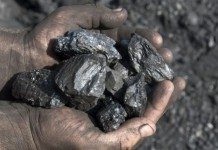
[miningmx.com] — COAL of Africa (CoAL) may need more funds to meet working capital requirements following lower-than-expected export revenues in the December quarter.
For the six months to end-December, CoAL suffered negative cash flows totalling A$97m which dropped the company’s cash balances to A23.7m as at December 31.
As of that date, CoAL had loan facilities of A$19.7m which had been fully drawn down and available credit standby arrangements of A$10.7m.
Cash outflow for the current March quarter is forecast at A$66.6m, of which $57.5m will be spent on production.
In the six months to end-December, CoAL spent A$104.1m on production but recouped only A$90.8m from that outlay in receipts from “product sales and related debtors’.
The company’s Vele colliery in Limpopo Province remains closed, and CoAL may be facing rising “take or pay’ penalties at the Matola coal export terminal in Maputo if it fails to meet its higher export commitments.
Expansion of the Matola terminal to a capacity of 6 million tonnes (mt) per year is expected to be completed in the March quarter. This will increase CoAL’s export allocation from 1mt/year to 3mt/year.
CoAL CEO John Wallington said in the December quarterly report:”Operating cash flows were impacted by rail and port performance. Commissioning of the Matola terminal upgrade is scheduled for completion by the middle of the March 2011 quarter and is expected to result in increased export volumes.
“Operational cost and cash flow controls have been substantially reviewed and are being significantly strengthened as CoAL transitions to a fully-fledged operational and project delivery company.
“The company is well advanced in assessing the various financing alternatives available,’ he said.
Regarding Vele – which has been closed since August after being served with a compliance notice by the department of environmental affairs (DEA) – Wallington said discussions were ongoing.
He said: “The company continued to interact with DEA representatives during the quarter and submitted the first set of rectification papers in terms of Section 24G of the South African National Environmental Management Act (Nema).
“In early January the company submitted the second set of Nema rectification papers. Pending the granting of the Integrated Water Use Licence and favourable rulings in terms of the 24G submissions, mobilisation and construction completion is expected to take up to 12 weeks, followed soon thereafter by production and the first sales of coking coal.’
Vele was visited by representatives from the United Nations Educational, Scientific and Cultural Organisation (Unesco) during the December quarter, along with senior officials from the DEA and the department of mineral resources.
Wallington said: “While the company awaits Unesco’s feedback, management remains confident that any issues identified can be satisfactorily resolved allowing for the commencent of operations at the colliery in early 2011.’
But Vele is also vehemently opposed by a coalition of non-government organisations (NGOs). They want the coal mine closed permanently because of the threat they believe it – and any other coal developments in the region – pose to the adjacent Mapungubwe National Park which is also a world heritage site, hence the Unesco involvement.
The NGOs are keeping up the pressure, with the announcement last week that they are about to submit a list of mining no go areas to minister of mineral resources Susan Shabangu ahead of the Mining Indaba conference to be held in Cape Town.
Melissa Fourie, executive director of the Centre for Environmental Rights, said Shabangu would be requested “to declare a defined list of areas of particular environmental sensitivity and value as no go areas for prospecting and mining – relying on a provision in the Mineral and Petroleum Resources Development Act.
“In addition, we ask her to impose a number of procedural restrictions on an additional, wider list of sensitive areas not covered by the proposed prohibition – restrictions designed to ensure a more rigorous EIA (environmental impact assessment) process for mining and prospecting in these areas.
“Both the ministers of mineral resources and water and environmental affairs have been aware of our plans to submit such a request for some months.’
Wallington has reiterated CoAL’s strategic development growth plans in his quarterly review.
He pointed out that after the acquisition of Rio Tinto’s Chapudi project, CoAL was the “majority resource owner in South Africa’s only known coking coal area, in an environment of rising global coal prices.
“CoAL intends to develop the coking coal properties and expects to seek either a domestic or export market for the thermal coal.
“The company also has the option to participate in further expansion at the Matola terminal (above 6mt) which is expected to significantly increase the capacity at the terminal.
“CoAL’s Matola terminal capacity and scale (of) presence in the Soutpansberg Basin will allow the company to develop the Maputo logistics corridor and leverage its future production into the export market.’











